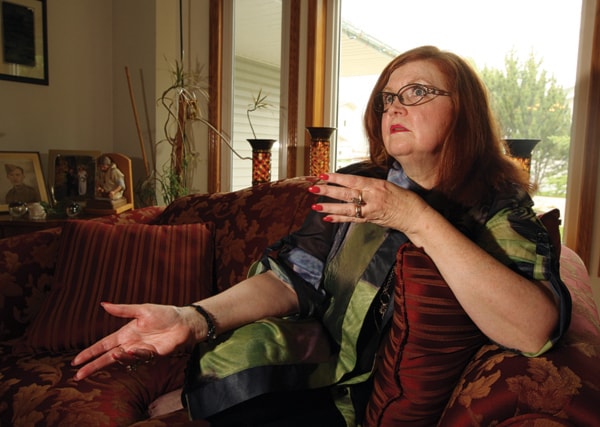On June 17, Robin Armitage was standing in her Red Deer kitchen, popping two pies in the oven, when she felt like something was vibrating in her apron.
Next, her left arm went suddenly limp.
The left side of her face felt numb, including the left side of her tongue.
“Of course I panicked and yelled for my husband right away,” said Armitage.
He called 9-1-1.
Not even five minutes later, the numbness went away and she felt fine.
“I felt sheepish when the ambulance arrived . . . I didn’t think I needed to go to the hospital. They have more important things to be attending to.”
But she went.
And it’s a good thing she did.
Armitage, 58, had just had a mini stroke, also known as a transient ischemic attack or a TIA.
This happens when a clot briefly stops blood from flowing to the brain.
“Emergency Services took my blood pressure and it was through the roof. . . . They insisted I go into the hospital just to check it out, as everything was a warning of a possible stroke.”
If you have a TIA, your risks of having a stroke are much higher, reports the Heart and Stroke Foundation.
While it turned out she didn’t require any treatment, going into the hospital and seeking medical help has also now allowed her to take measures to prevent a full-on stroke, said Armitage.
She underwent various tests and assessments three days after her TIA and was scheduled to see a neurologist to try to pinpoint the cause.
She plans to start exercising more.
“They said to me at Red Deer Regional that it’s really important to go into the hospital even if your symptoms go away. Part of the reason so many people have serious strokes is because they ignore the TIAs they experience beforehand,” she said.
Each year, there are over 50,000 strokes in Canada. That’s one stroke every 10 minutes.
Nearly 14,000 Canadians die from stroke on an annual basis.
June was national stroke month and the Heart and Stroke Foundation of Alberta, N.W.T. and Nunavut is spreading the word about stroke symptoms and how crucial it is to get medical attention immediately.
Two-thirds of Albertans arrive at the hospital too late for stroke treatments that can prevent damage, reduce disability and save lives, reports the foundation.
For each hour of delay in treating a stroke, the brain loses as many neurons as it does in almost 3.6 years of normal aging.
The Red Deer Regional Hospital Centre has been working hard over the years to develop a more co-ordinated approach when it comes to handling stroke cases, said Rob Swanson, director of medical, surgery and inpatient services.
Since 2008, there has been a primary stroke centre on site, which allows for special consultation and quicker administration of clot-busting medicine.
This centre is also connected through TeleStroke on the internet to neurologists in Calgary and Edmonton for additional patient diagnosis and treatment prescription.
The hospital also has a stroke prevention clinic.
This is a way for those with TIAs to receive early assessments and case management help when it comes to changing their lifestyles to reduce the risk of a future stroke.
The clinic sees on average 50 new referred patients per month, said Swanson.
The total number of stroke patients the hospital sees has increased every year, said Swanson.
In 2011, there were 298, whereas in 2006, there were only 147 cases. In 2010, there were 210.
“By and large, we are continuing to work to improve the system,” said Swanson. “Our best efforts have to be focused on stroke prevention in the first place, such as controlling and managing diabetes and high cholesterol, staying in shape, and avoiding excessive alcohol consumption.”
Staff at Red Deer Regional were “awesome” for Armitage and very informative.
The only thing that irked her, she said, was when they told her she can no longer donate blood.
For Grace Baxter of Sylvan Lake, however, her experience with stroke treatment was not so great.
Her son, Rob, had a major stroke when he was 24.
It was later discovered he had a hole in his heart, said Baxter.
Six years later, he’s still recovering.
“When he was brought into the hospital, they left him,” said Baxter. “They thought he was on drugs but really he’d just had a major stroke.”
It should never have happened that way, she said.
Rob lost the use of his left side and while he could walk, it was only about three weeks ago that he got all feeling back in the fingers of his left hand.
They were told that whatever feeling and movement he got back after two years was all he would get back.
“No one should ever be told that; you have to keep hope,” said Baxter. “It’s been a long, hard journey.”
The impact that stroke has on survivors varies from individual to individual, said Kate Chidester, vice-president of health and research for the Heart and Stroke Foundation of Alberta, N.W.T. and Nunavut.
“The most common side effects are physical, weakness of one side of the body, walking with a cane, limping,” said Chidester.
“Vision problems in one or both eyes is also common along with aphasia, which is difficulty speaking, writing, reading or understanding language.”
Stroke has also been linked to causing vascular dementia and mild personality changes, she noted, as there are a lot of emotional changes for stroke patients.
“With new research every day, there is never a set time limit for stroke recovery periods. People are reaching new heights in their rehabilitation all the time, years and years after stroke.”
She encourages anyone who has suffered a stroke to check out the foundation’s support program, Living with Stroke.
For more information on the program and where it’s offered in Alberta, call 403-264-5549 or visit www.heartandstroke.com.
rfrancoeur@www.reddeeradvocate.com
